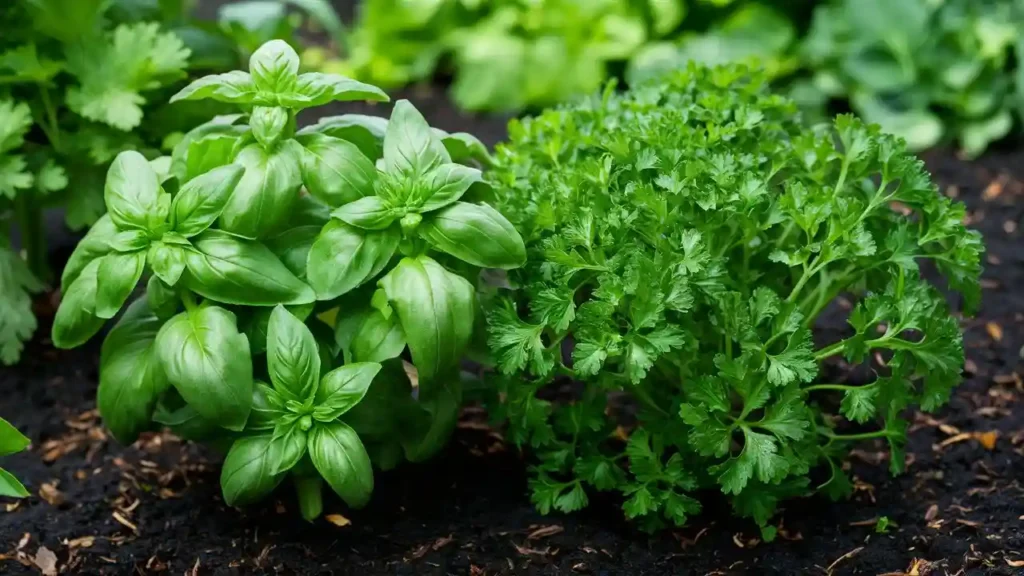Can I Plant Basil And Parsley Together?
Yes, you can plant basil and parsley together. They are both herbs that enjoy full sun and well-drained soil. Basil is a good companion plant for parsley, as it helps to repel insects. Parsley is a good companion plant for basil, as it helps to improve the flavor of the basil. When planting basil and parsley together, plant them about 6 inches apart.
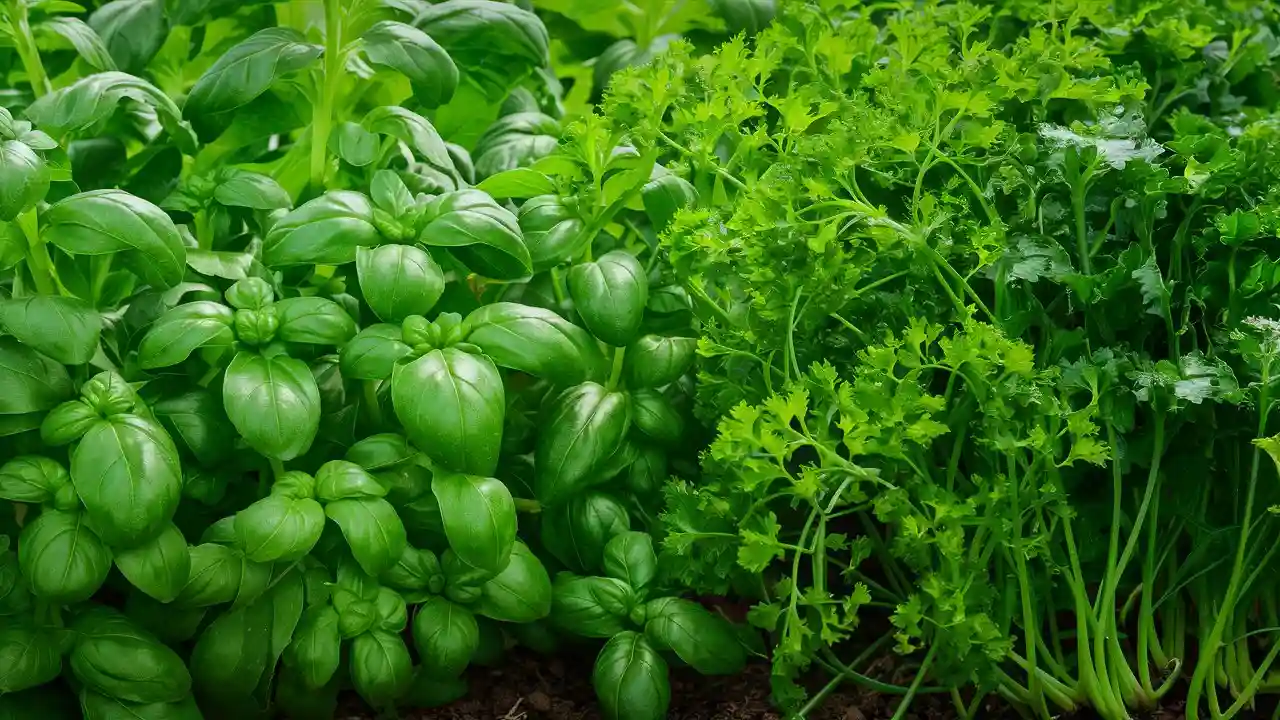
Companion Planting Basil and Parsley
Basil and parsley are two popular culinary herbs that can be easily grown together in a companion planting arrangement. Companion planting is a gardening technique that involves planting different species of plants together to create a mutually beneficial relationship. In the case of basil and parsley, these two herbs complement each other in several ways, resulting in improved growth and health for both plants.
One of the primary benefits of companion planting basil and parsley is their ability to deter pests. Basil is known to repel insects such as aphids, whiteflies, and mosquitoes, while parsley attracts beneficial insects like ladybugs and lacewings, which prey on common garden pests. By planting these two herbs together, you can create a natural pest control system in your garden.
In addition to pest control, basil and parsley also provide mutual benefits in terms of pollination and flavor enhancement. Basil’s vibrant flowers attract pollinators such as bees and butterflies, which can also benefit other plants in your garden. On the other hand, Parsley has a strong aroma that can help improve the basil flavor, making it a valuable companion plant for culinary purposes.
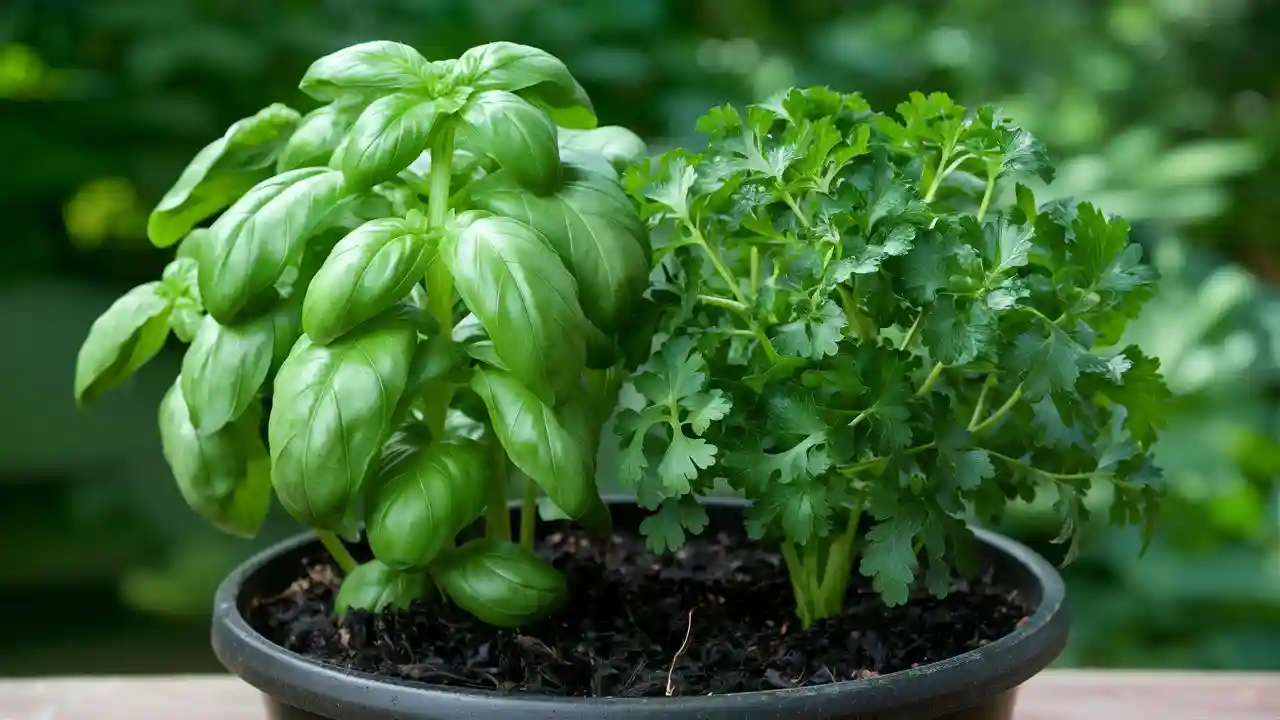
Growing Basil and Parsley Together
Basil and parsley are two popular herbs that can be easily grown together in a companion planting arrangement. Companion planting is the practice of growing different plant species in close proximity to benefit from their mutual interactions.
When grown together, basil and parsley can provide several advantages:
- Improved growth: Basil is a heavy feeder that requires a lot of nutrients from the soil. Parsley, on the other hand, is a light feeder that does not require as many nutrients. By planting parsley next to basil, you can help to improve the growth of both plants.
- Pest control: Basil is known to repel certain pests, such as aphids and whiteflies. Parsley, on the other hand, attracts beneficial insects, such as ladybugs and lacewings. By planting these two herbs together, you can help to create a natural pest control system in your garden.
- Pollination: Basil and parsley are both attractive to pollinators, such as bees and butterflies. By planting these herbs together, you can help attract pollinators to your garden, which will benefit other plants in your garden as well.
Planting Basil and Parsley in the Same Pot
Growing basil and parsley in the same pot is a space-saving solution for small gardens or balconies. Here’s how to do it:
1. Choose the right pot: Select a pot that is at least 12 inches in diameter and has drainage holes.
2. Prepare the soil: Fill the pot with a well-draining potting mix that is rich in organic matter.
3. Plant the basil and parsley: Plant the basil seedlings or seeds in the center of the pot. Plant the parsley seedlings or seeds around the perimeter of the pot, about 6 inches apart.
4. Water and fertilize: Water the plants deeply after planting. Fertilize them monthly with a balanced liquid fertilizer.
5. Provide support: As the basil plants grow, they will need support to prevent them from falling over. You can use a tomato cage or stakes to support them.
6. Harvest: Basil and parsley can be harvested as needed. To harvest basil, pinch off the top leaves of the plant. To harvest parsley, cut the leaves at the base of the plant.
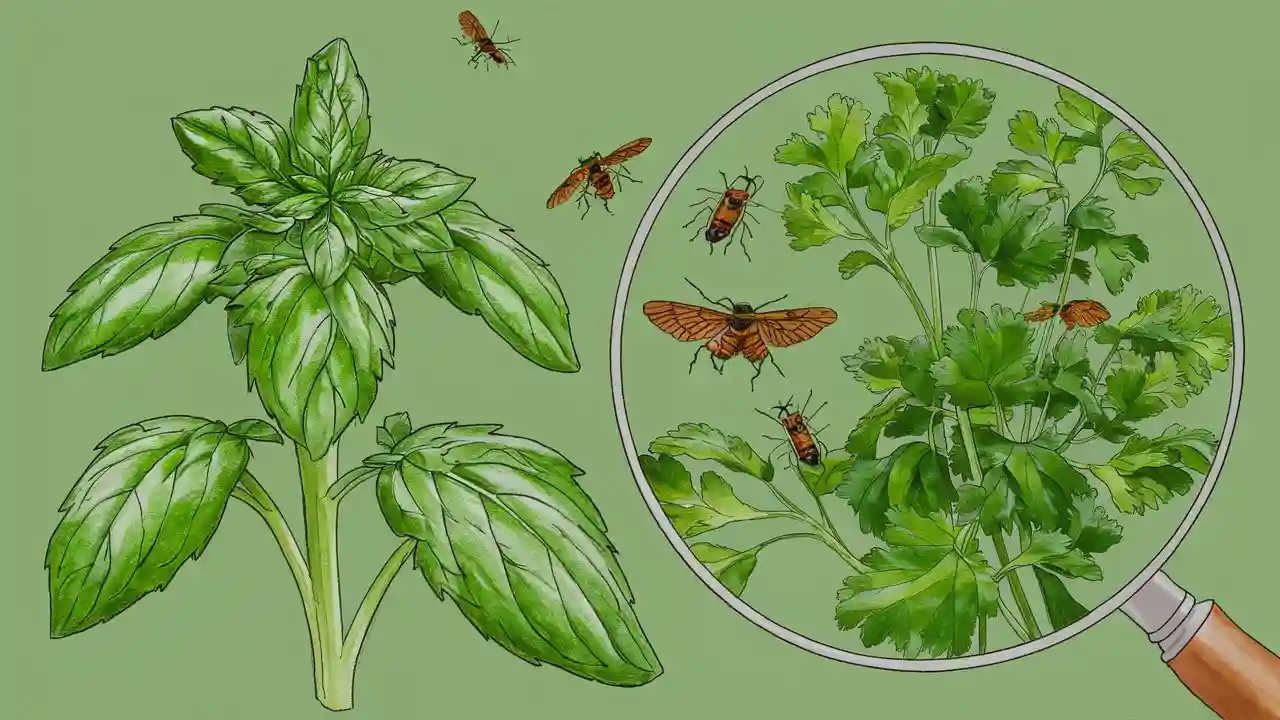
Basil and Parsley Companion Planting Benefits
Companion planting basil and parsley offers a multitude of benefits that enhance the growth and well-being of both plants. Here are the key advantages:
Pest Control: Basil acts as a natural pest repellent, deterring insects like aphids and whiteflies that can harm parsley. The strong scent of basil masks the presence of parsley, making it less attractive to pests.
Pollination: The fragrant flowers of basil attract pollinators like bees and butterflies, which also visit parsley flowers. This cross-pollination improves the fruit and seed production of both plants.
Flavor Enhancement: The aromatic compounds in basil complement the fresh, herbaceous flavor of parsley. Planting them together creates a harmonious blend that enhances the taste of dishes.
Soil Health: Basil can absorb and release nutrients into the soil, benefiting parsley’s growth. Additionally, the deep roots of basil help aerate the soil, improving drainage and providing oxygen to parsley’s shallow roots.
Aesthetic Appeal: The contrasting colors and textures of basil and parsley create a visually appealing combination in the garden or on a kitchen windowsill. The upright growth habit of basil provides support for the sprawling parsley plants, creating a vertical gardening effect.
Basil and Parsley Planting Guide
Step 1: Choose a planting location. Basil and parsley prefer full sun to partial shade and well-drained soil. If you are planting in the ground, amend the soil with compost or manure to improve drainage. If you are planting in containers, use a potting mix specifically designed for container gardening.
Step 2: Plant the basil and parsley seedlings. Space the basil plants 6-8 inches apart and the parsley plants 4-6 inches apart. Water the seedlings deeply after planting.
Step 3: Mulch around the plants. Mulching helps to retain moisture, suppress weeds, and regulate soil temperature. Use a layer of organic mulch, such as straw, hay, or compost, around the plants.
Step 4: Water the plants regularly. Basil and parsley need regular watering, especially during hot, dry weather. Water the plants deeply, but avoid overwatering.
Step 5: Fertilize the plants monthly. Use a balanced fertilizer, such as a 10-10-10 fertilizer, to fertilize the plants monthly. Follow the directions on the fertilizer package for the correct application rate.
Step 6: Harvest the basil and parsley. Basil and parsley can be harvested throughout the growing season. Harvest the leaves as needed. To harvest basil, pinch off the top 2-3 inches of the stem. To harvest parsley, cut the leaves at the base of the plant.

Companion Planting Basil and Parsley for Pest Control
Basil and parsley are both known to repel certain pests, making them excellent companion plants for each other. Basil, with its strong aroma, deters flies, mosquitoes, and other flying insects. Parsley, on the other hand, repels aphids, spider mites, and other common garden pests. By planting these herbs together, you can create a natural pest control barrier in your garden.
To maximize the pest-repelling effects, plant basil and parsley near each other. You can interplant them in the same bed or grow them in containers side by side. As the plants grow, their scents will mingle and create a powerful pest-repellent zone.
In addition to repelling pests, basil and parsley can also attract beneficial insects to your garden. Basil attracts pollinators like bees and butterflies, while parsley attracts parasitic wasps that prey on aphids and other pests. By creating a diverse and beneficial ecosystem in your garden, you can reduce the need for chemical pesticides and promote a healthy and thriving plant community.

Basil and Parsley Companion Planting for Pollination
Basil and parsley are both attractive to pollinators, such as bees and butterflies. By planting these herbs together, you can create a welcoming environment for these beneficial insects. Pollinators play a vital role in the reproduction of many plants, including fruits, vegetables, and flowers. By attracting pollinators to your garden, you can help to increase your overall harvest and support the local ecosystem.
To maximize the pollination benefits of companion planting basil and parsley, plant them in a sunny location with well-drained soil. Water the plants regularly and fertilize them monthly with a balanced fertilizer. You can also deadhead the spent flowers to encourage new growth and flowering.
By following these tips, you can create a beautiful and productive garden that is also beneficial to pollinators. Basil and parsley are a great companion planting pair that can provide you with a variety of benefits, including increased pollination, pest control, and flavor enhancement.
Basil and Parsley Companion Planting for Flavor Enhancement
Basil and parsley are both aromatic herbs that can add a burst of flavor to your dishes. When planted together, they can complement each other’s flavors and create a harmonious blend. The sweet and slightly spicy notes of basil pair well with the fresh and earthy flavors of parsley, resulting in a versatile combination that can enhance a wide range of culinary creations.
In addition to their flavors, basil and parsley also release volatile compounds that interact with each other. These compounds can enhance the overall aroma and taste of both herbs, making them even more flavorful when grown together. The combination of basil and parsley is particularly well-suited for dishes that require a balance of sweet and savory flavors, such as salads, soups, stews, and pasta sauces.
By companion planting basil and parsley, you can not only enjoy the benefits of their flavors but also create a flavorful synergy that will elevate your culinary creations to the next level.
Companion Planting Basil and Parsley for Soil Health
Basil and parsley are both excellent companion plants for improving soil health. Basil is a heavy feeder that requires nitrogen-rich soil, while parsley is a light feeder that prefers well-drained soil. When planted together, basil and parsley can help to balance the soil’s nutrient content and improve its overall structure.
Basil’s deep roots help to aerate the soil and improve drainage, while parsley’s shallow roots help to hold the soil in place and prevent erosion. In addition, parsley leaves contain compounds that can help to suppress soil-borne diseases.
By planting basil and parsley together, you can create a healthy and productive garden ecosystem that will benefit your plants and your soil for years to come.
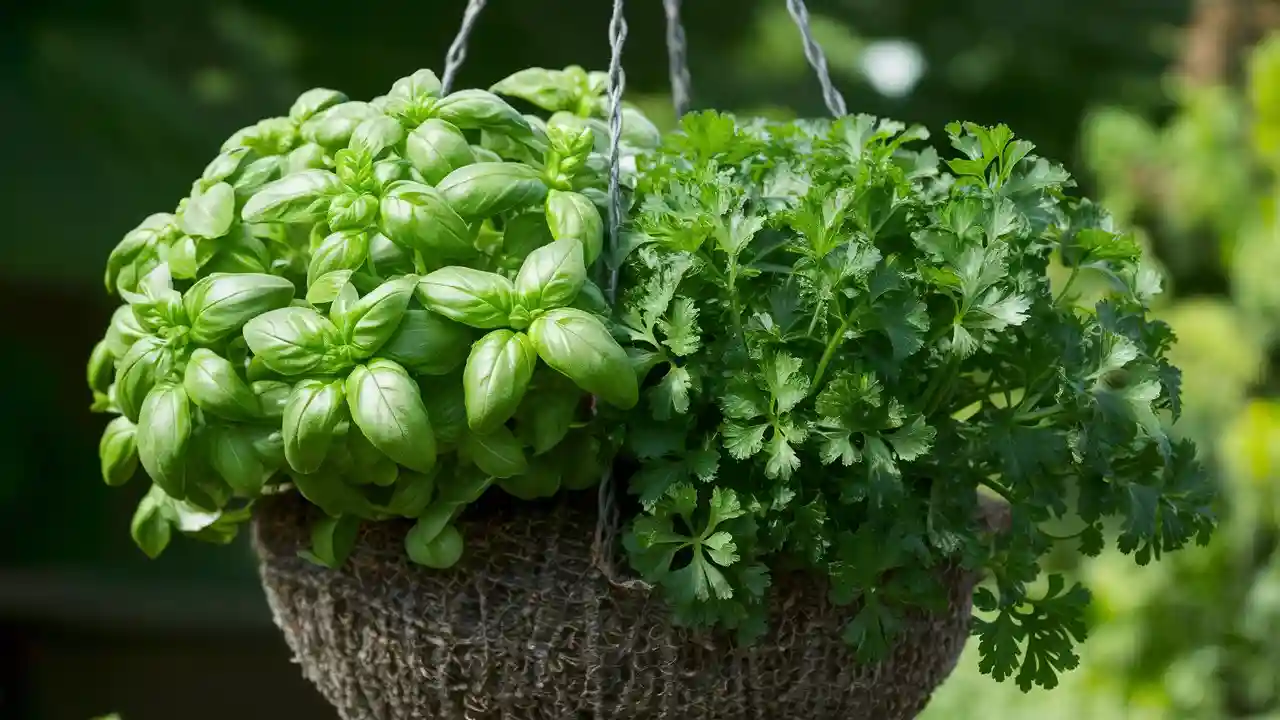
Companion Planting Basil and Parsley for Aesthetic Appeal
Not only do basil and parsley offer culinary and practical benefits, but they also create a visually appealing combination in the garden. Basil’s vibrant green leaves contrast beautifully with parsley’s darker, more muted hue. The different textures of the two plants add depth and interest to any garden bed or container.
When planted together, basil and parsley can create a stunning vertical effect. Basil’s upright growth habit provides a backdrop for parsley’s cascading foliage. This combination is perfect for adding height and visual interest to borders, raised beds, or hanging baskets.
In addition to their aesthetic appeal, basil and parsley can also attract beneficial insects to the garden. Bees and butterflies are drawn to the fragrant flowers of basil, while parsley provides a food source for caterpillars. By planting these two herbs together, you can create a vibrant and welcoming environment for a variety of wildlife.
Frequently Asked Questions
- What are the benefits of companion planting basil and parsley?
There are many benefits to companion planting basil and parsley, including:- Pest control: Basil is known to repel insects such as aphids, whiteflies, and mosquitoes, while parsley attracts beneficial insects like ladybugs and lacewings, which prey on common garden pests.
- Pollination: Basil’s vibrant flowers attract pollinators such as bees and butterflies, which can also benefit other plants in your garden.
- Flavor enhancement: Basil and parsley have complementary flavors that can enhance each other when used in cooking.
- Soil health: Basil and parsley have different nutrient requirements and root structures, which can help to improve the overall health of the soil.
- Aesthetic appeal: Basil and parsley have contrasting colors and textures that can create a visually appealing combination in the garden.
- How do I plant basil and parsley together?
To plant basil and parsley together, follow these steps:- Choose a planting location that receives full sun to partial shade and has well-drained soil.
- Amend the soil with compost or manure to improve drainage and fertility.
- Plant the basil and parsley seedlings or seeds according to the spacing recommendations on the seed packet.
- Water the plants deeply after planting.
- Mulch around the plants to help retain moisture and suppress weeds.
- How do I care for basil and parsley?
To care for basil and parsley, follow these tips:- Water the plants regularly, especially during hot, dry weather.
- Fertilize the plants monthly with a balanced fertilizer.
- Pinch off the tips of the basil plants to encourage bushier growth.
- Harvest the basil and parsley leaves as needed.
